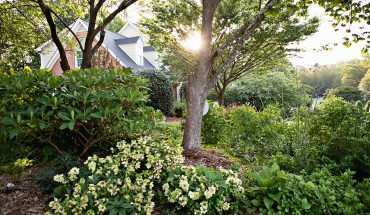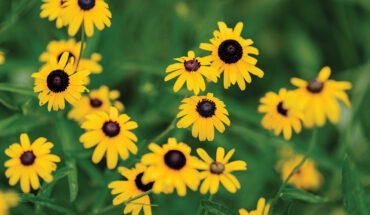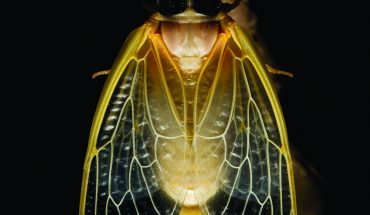 by Tony Avent
by Tony Avent
illustration by Ippy Patterson
I’ll always remember the day I spotted my first edgeworthia, tucked beside the narrow, dark, windy path that used to lead past the old lath house at the J.C. Raulston Arboretum. There it was, naked as a proverbial jaybird in the middle of winter, except for the terminal flowers that stared back, as if to say: “OK, you found me.”
This began a life quest to learn more about this amazing daphne relative. I started by taking cuttings from the Arboretum plant and planting them all around the N.C. State Fairgrounds, where I worked at the time. Unfortunately, all of those plants later fell victim to subsequent landscape directors who didn’t realize what they had.
My path of edgeworthia discovery then took me to Georgia, where a native population of the plant had reportedly been discovered. My research trail there led to the house of a former U.S. ambassador, who had brought an edgeworthia specimen back from China. It turned out that a few seedlings from this imported plant had been washed down a nearby stream, where they were discovered by native plant enthusiasts who assumed them to be native.
Next was a trip to Kingston, Wa., to see plantsman Dan Hinkley, who had a large specimen in his garden. The Hinkley plant, edgeworthia chrysantha, had much larger foliage and flowers than the Raulston Arboretum’s edgeworthia papyrifera, combined with an incredible sweet floral fragrance.
About this time, Piroche Plants of Canada began importing the first large shipment of edgeworthia from China. I was fortunate to cherry pick a particularly large-leafed and large-flowered specimen for my home garden, which we still grow today under the name edgeworthia chrysantha “Snow Cream.”
Then in 1996, I headed to Yunnan, China, with the hope of seeing the plant in the wild. While I never found it in its natural habitat, I did get to see a huge specimen in the Kunming Botanical Garden, which was identical to the plant we were growing at home.
The taxonomy of edgeworthia has been enough to drive even the most stable of us insane. Despite there being only four species in the genus, agreement on which one is which seems to change more often than some women change shoes.
Current thinking is that what we grow as edgeworthia chrysantha is what’s known as a tetraploid, meaning it has a double set of chromosomes, while the smaller-growing, nonfragrant plant known as edgeworthia papyrifera is simply a diploid form of the same species. The other species – the evergreen E. gardneri, E. albiflora and E. eriosolanoides – don’t appear to be in cultivation.
So, what’s so exciting about edgeworthia?
All summer, the eight-foot tall by 10-foot wide umbrella shaped shrub, supported by a smooth brown trunk, is adorned with tropical-looking, plumeria-like leaves. As long as the soil is well drained, edgeworthia grows equally as well in half-day sun or shade. The foliage drops in mid December to reveal both the plant’s wonderful bark and its large, silvery terminal flower buds.
The flower buds open steadily from mid January to early April, producing an overwhelmingly fragrant display of pendent, golden yellow flowers. Although there is an orange-red form, edgeworthia akebono (or Red Dragon) on the market, it is unfortunately the nonfragrant, shorter, diploid form.
You’re probably wondering about edgeworthia’s common name, but unfortunately, plants must become common before they acquire a common name, and edgeworthia isn’t there yet. Then again, we can take care of that right now, by anointing it “winter false daphne.”
I can think of few plants that add as much to the winter garden as the incredible edgeworthia chrysantha and I hope everyone will add one to the garden.



